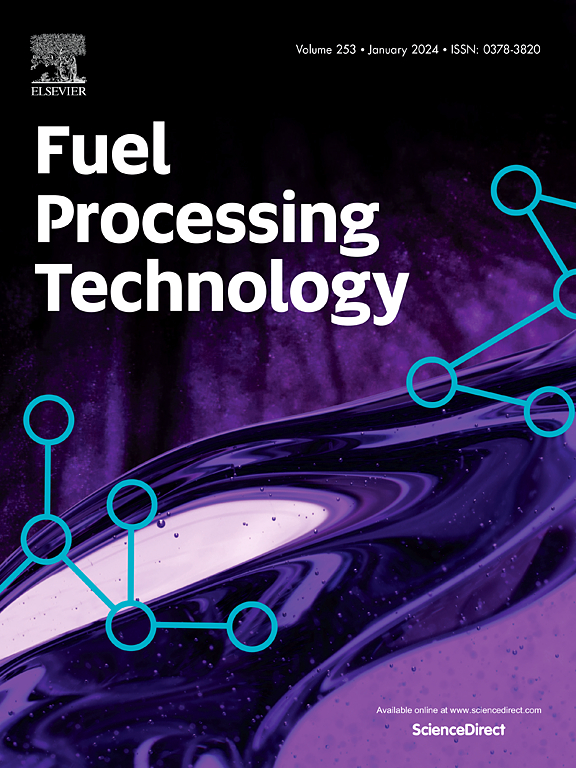Research on the effects of negative valve overlap duration on the combustion and emission of methanol, ethanol, isopropanol, and n-butanol in a spark induced compression ignition (SICI) engine by experiments and Artificial Neural Networks
IF 7.2
2区 工程技术
Q1 CHEMISTRY, APPLIED
引用次数: 0
Abstract
In order to achieve the carbon neutrality goal, it is urgent to improve the thermal efficiency of engines and the application of carbon neutral fuels. Due to the low emissions and renewability of alcohols, which are considered as potential alternative fuels. Spark induced compression ignition (SICI) is an efficient and clean combustion mode for future engines. This article studied the differences of methanol, ethanol, isopropanol, and n-butanol in the SICI combustion modes under four different negative valve overlap (NVO). It was found that under low load, methanol exhibited higher indicated thermal efficiency (ITE) and the lowest HC emissions, while n-butanol exhibited lower NOx and CO emissions. After the load increased, the ITE of n-butanol, isopropanol, methanol, and ethanol all increased with the prolongation of NVO, increasing by 0.35 %, 0.95 %, 0.9 %, and 1.42 %, respectively. In addition, an artificial neural network SICI engines model was established, with correlation coefficients above 0.95. It was found that a correlation between fuel characteristics, auto-ignition timing and flame development. The correlation weight was 20.68 % and 48.1 %, respectively. For ITE, within the optimal ignition timing adjustment range, the contribution of latent heat of vaporization and auto-ignition temperature of alcohol was 42.5 % and 46.5 %, while NVO was 6.63 %.
通过实验和人工神经网络研究了负气门重叠时间对火花诱导压缩点火(SICI)发动机中甲醇、乙醇、异丙醇和正丁醇燃烧和排放的影响
为了实现碳中和的目标,提高发动机的热效率和碳中性燃料的应用迫在眉睫。由于酒精的低排放和可再生,被认为是潜在的替代燃料。火花诱导压缩点火(SICI)是未来发动机高效、清洁的燃烧方式。本文研究了甲醇、乙醇、异丙醇和正丁醇在四种不同负气门重叠(NVO)下SICI燃烧模式的差异。结果表明,在低负荷下,甲醇表现出较高的指示热效率(ITE)和最低的HC排放,而正丁醇表现出较低的NOx和CO排放。负载增加后,正丁醇、异丙醇、甲醇和乙醇的ITE均随着NVO的延长而增加,分别增加了0.35%、0.95%、0.9%和1.42%。建立了SICI发动机人工神经网络模型,相关系数在0.95以上。发现了燃料特性、自燃时间和火焰发展之间的相关性。相关权重分别为20.68%和48.1%。在最佳点火时间调节范围内,酒精汽化潜热和自燃温度的贡献率分别为42.5%和46.5%,而NVO的贡献率为6.63%。
本文章由计算机程序翻译,如有差异,请以英文原文为准。
求助全文
约1分钟内获得全文
求助全文
来源期刊

Fuel Processing Technology
工程技术-工程:化工
CiteScore
13.20
自引率
9.30%
发文量
398
审稿时长
26 days
期刊介绍:
Fuel Processing Technology (FPT) deals with the scientific and technological aspects of converting fossil and renewable resources to clean fuels, value-added chemicals, fuel-related advanced carbon materials and by-products. In addition to the traditional non-nuclear fossil fuels, biomass and wastes, papers on the integration of renewables such as solar and wind energy and energy storage into the fuel processing processes, as well as papers on the production and conversion of non-carbon-containing fuels such as hydrogen and ammonia, are also welcome. While chemical conversion is emphasized, papers on advanced physical conversion processes are also considered for publication in FPT. Papers on the fundamental aspects of fuel structure and properties will also be considered.
 求助内容:
求助内容: 应助结果提醒方式:
应助结果提醒方式:


